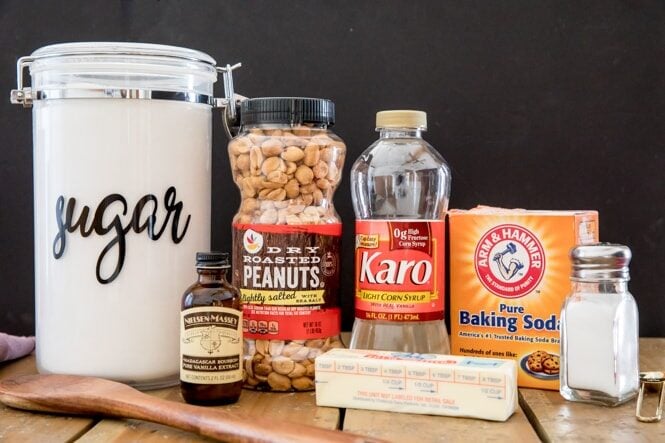You can make sweet & snappy, old-fashioned Peanut Brittle right in your own kitchen! Today’s peanut brittle recipe includes all my best candy making tips so you can have flawless results every time. Recipe includes a how-to video!
Be sure to use a candy thermometer to ensure it reaches 300 degrees F or hard crack stage. What does baking soda do to peanut brittle? Adding a little baking soda aerates the peanut brittle causing it to expand slightly for a crunchy texture that won’t break your teeth when you chew it.

An Easy Homemade Peanut Brittle Recipe
Peanut brittle is a flavorful, old-fashioned candy that’s sweet and salty with a beautiful snappy texture (and a reputation for sticking to your teeth!). Salted peanuts are scattered throughout for a nutty flavor and fun bite. If you’re a fan of peanut candy, you’ll definitely like this one!
Candy making may seem intimidating, but that’s just because most of us don’t make it often. I get that and for a long time stuck to thermometer-free candies like potato candy but using a thermometer and moving your candy-making to the stovetop really isn’t that complicated. Take this recipe as an opportunity to become familiar with the tools and develop a knack for the process. Today I’m sharing my best tips and tricks so you can jump right in!
One thing to note before we begin: I highly recommend making this recipe on a dry, low humidity day (so winter is a great time to start practicing!). Any moisture in the air can be re-absorbed into your candy, making it softer, and we want our candy to be hard and brittle (hence the name!). Humidity also slows the cooling process while your candy is setting, increasing the chances of having unwanted crystals form. So not a bad idea to check the weather forecast before you start!

As like with my toffee recipe, it’s very important to have all of your ingredients laid out before you start. Once your mixture reaches 305°F, you need to move quickly as possible! Here’s what you need:
- Butter. Use unsalted butter (since we’re using salted peanuts and adding salt ourselves!) and make sure it’s softened.
- Baking soda. I talk about this in-depth below, but essentially baking soda creates the proper texture and flavor in any good peanut brittle recipe. Make sure you’re not using baking powder!
- Peanuts. Use shelled, dry roasted peanuts and make sure they’re salted. This helps give our brittle a nice salty and sweet flavor!
- Light corn syrup. This is a crucial ingredient in many candies (like my homemade caramels), and it’s NOT the same thing as high fructose corn syrup! Stick with the light version here and save dark corn syrup for pecan pie.
SAM’S TIP: I strongly recommend using a candy thermometer for this recipe. While there are certainly ways to make candy without one, using a thermometer saves you guesswork and frustration.
Remember, this is just an overview of the ingredients I used and why. For the full recipe please scroll down to the bottom of the post!
Baking soda is a crucial ingredient that can’t be substituted in this recipe. Just as in homemade syrup or caramel corn, baking soda causes a unique chemical reaction (basically a lot of rising foam) that is crucial in creating the right texture in peanut brittle. If you make it without baking soda but you will notice the brittle is a bit harder to bite through.
There’s just something special about old-fashioned recipes like peanut brittle. My other favorite old-fashioned recipes include Grandma’s Oatmeal Cake, Baked Apples and Baked Rice Pudding.
Every holiday season my grandmother used to make a few batches of peanut brittle. She always dropped a container at our house and it lasted all season. I can’t help but think of her when I think of this Peanut brittle recipe.
This easy homemade Peanut Brittle is an old-fashioned sweet, hard candy made on the stovetop with six simple ingredients and roasted peanuts. It’s a family favorite during the holidays but can be enjoyed any time of year!
Wear gloves and be CAREFUL! The candy gets VERY hot and can easily spill onto your hands or wrists during pouring if you’re not careful. Make sure to use cooking/oven mitts (that you don’t mind getting dirty) and be sure to tilt the pan away from you and use a spatula to scrape the hot mixture onto the sheet pan.
Adding Baking Soda to a Peanut Brittle Recipe
FAQ
Why do you put baking soda in peanut brittle?
Why did my peanut brittle turned out chewy?
Why didn’t my homemade peanut brittle get hard?
What does baking soda do in candy making?
